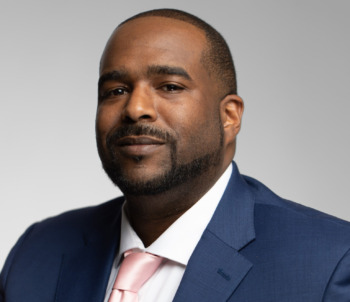As Azia Ruff scrolled, an “icky” feeling came over her.
She was clicking through the website for Lifeline WA, a $750,000 pilot program announced last year by the state of Washington. It aimed to serve as a hub for youth who had been through foster care or other state systems, connecting them with services and funding for housing, food and employment.
Listen and follow: Spotify | Apple Podcasts | Google Podcasts | Pocket Casts | RadioPublic
Ruff has spent years pushing for better child welfare and youth homelessness policies, primarily in Washington, where she lives. As an advocate who experienced the foster care system herself, she has a keen eye for what a person seeking help might need to know.
And she said Lifeline, based on its website, did not offer much.
“It was very exciting, promising language,” Ruff said, pointing to lines like, “Help where you need it. When you need it.” But, even if someone could find it buried under dozens of similarly named search results, the program’s website still lacked concrete details about what that “help” looked like, and — crucially — who qualified. It also did not list its hotline number or offer any other immediate contact through increasingly common accessibility options like text or web chat.
The only way to learn more, Ruff noted, was to submit her personal information in a formal request for help, and wait.
Envisioned as a pilot for a statewide “no-wrong-door access point” for youth at risk of homelessness, Lifeline was supposed to start helping young people across Washington by the end of June 2023. Instead, it publicly launched in a single county in August. Clear data on whom Lifeline has served and what help the hotline has provided remains limited. And promised website updates to make services easier to find and access have stalled for months.
[Related: Washington state young adults often end up homeless after leaving treatment]
The company the state chose to operate Lifeline, SDMC Consulting, is a lobbying firm with little experience offering direct services. The firm has invoiced the state for hundreds of thousands of dollars intended to directly help young people with housing, food, and other needs — but much of that money is still sitting in a bank account or at an online gift card service. The pilot has since been renewed for another two years and received additional funding.
In 2021, nearly one in six of the approximately 7,300 youth and young adults — more than half of them people of color — exiting Washington state foster care, justice or behavioral health systems were homeless a year later. The Lifeline pilot was supposed to test whether the program could serve as a crucial safety net for those who have left state care. Ideally, it would pave the way for long-term funding to close a key service gap for young people making this precarious transition, and maybe serve as a model for similar efforts elsewhere.
But first the model has to work.
Sam Martin, SDMC’s CEO and a registered lobbyist, acknowledged early delays in standing up services.
“I wish that we would’ve gotten it open or launched a lot faster,” Martin told Crosscut and Youth Today in an interview from his home in Renton, Washington. “But I’m confident that taking a little bit more time was the right thing to do.”
A lack of clarity

Courtesy Sam Martin
CEO of SDM Consulting Sam Martin. Lobbying group SDMC was chosen by the state to launch and operate the Lifeline program.
Lifeline ideally serves as a hotline and hub where young people who have left state systems can get help connecting to local support services or receive financial assistance if needed. They could have minor needs or major ones — paying a utility bill, tracking down medical records or finding an apartment. In theory, whatever the problem is, Lifeline can help.
Right now, young people can request help through the application form at lifelinewa.org or call the toll-free number, 1-866-256-3058, which is staffed from 8 a.m. to 8 p.m. on weekdays and 10 a.m. to 4 p.m. on weekends. Requests also come to Lifeline through direct case manager referrals.
[Related: Researchers team up with court staff to help Washington homeless youth]
After assessing a young person’s needs, Lifeline will first try to connect them to an existing provider that can address the need, Martin said. But if no such organization exists, or if getting help would take too long, Lifeline may step in.
“All these people are ending up homeless,” Martin said, “and there’s nothing that anybody’s doing for them.”
For simple requests, Lifeline can provide cash assistance through gift cards or by paying for single expenses of up to $500, as long as the person is in a county where Lifeline operates — which for now is just Spokane. If a person’s situation is more complex, Lifeline can provide case management and cover costs totaling up to $5,000 each year.
Martin said that Lifeline could help young people outside Spokane County by navigating and connecting them with resources, but acknowledged that the program could not offer them financial assistance.
Lifeline began unofficially with a “soft” launch in May when its website quietly went live. In an interview that month, Martin listed a host of updates that SDMC was working on for Lifeline: better search engine optimization, so young people could readily find the website. A phone line. Data collection. A chat option, on the website.
Over the summer, Lifeline received about 15 referrals, according to Martin. Records requests revealed that as of July SDMC had not provided state officials with required monthly reports documenting the numbers, demographics, and service outcomes of their clients. Martin acknowledged in August that they had only recently started tracking that data in Salesforce.
Starting a new program can be challenging in the best of circumstances. In a report on Lifeline submitted to the Legislature earlier this year, the state’s Office of Homeless Youth implied that from the very beginning, Lifeline was not set up to succeed.
“Six months was insufficient to build infrastructure, train staff, conduct outreach and marketing, and have enough information to adequately evaluate the program,” the report said. It also criticized “the ambiguity of the project’s scope,” saying it wasn’t clear whom Lifeline targeted.
Building the website, phone line, and a data management system “took a lot of time and energy,” Martin said when asked to account for Lifeline’s delays. He also repeatedly cited “intentionality” in the design process, drawing on the perspectives of young people with experience in state systems or homelessness. He could not connect Youth Today and Crosscut with any young people involved in the design process.
[Related: Washington homelessness group exposed sensitive data on kids, young adults]
Two employees, at least one of whom held a managerial role in Lifeline, also left SDMC a few months ago. SDMC is still searching for a case manager, and currently has three part-time intake specialists and one full-time case manager.
Lifeline had received 35 referrals as of early September, according to the most recent data SDMC could share. The firm said that the actual number is higher. That figure represents all cases entered into Lifeline’s system, including people whom Lifeline ultimately couldn’t help.
Since Lifeline’s official public launch, the number of calls and website submissions has surged from one to three per week to six to nine a day, said Courtney Jackson, Lifeline’s program manager and SDMC’s chief strategic officer, noting that those numbers were anecdotal.
“In my view, this is going well,” said Kim Justice, the executive director of the state’s Office of Homeless Youth, who said she had been “pretty involved” in Lifeline. She disputed the notion that Lifeline was delayed, saying that it had met deadlines mandated by the Legislature.
At the end of September, Lifeline could not provide up-to-date numbers on clients and outcomes. As of late October, its website did not outline any details on geographic eligibility for navigational and financial services. It did not offer text or chat contact points that Martin described in multiple interviews as “coming soon.” And it did not list its hotline phone number anywhere.
Ruff, the regional advocate, said she worries that because the website offers so little information about eligibility, it could actually cause harm or waste the time of young people hoping for help.
“It’s such a demoralizing experience to go after something that you think will help you,” she said, only to discover you’re not eligible due to “one glaringly obvious detail.”
‘The right way to do things’
The idea for Lifeline came from Daniel Lugo when he was the legislative assistant to State Rep. Frank Chopp, a former speaker of the Washington House of Representatives. Lugo himself had faced challenges when he aged out of Washington’s foster care system. For a young person without family support, small problems can escalate into crises, Lugo explained. Lifeline could be a stabilizing force, helping a person become or remain independent without the trauma of becoming homeless or re-entering a state-run system.
“That is the right way to do things,” Lugo told Crosscut and Youth Today.

Caroline Walker Evans/For Crosscut
Daniel Lugo, stands for a portrait in Volunteer Park, Seattle, Wash. When Lugo was a legislative assistant for State Rep. Frank Chopp, he came up with the idea for Lifeline WA, a pilot program aimed at connecting youth in foster care or other state systems with services and funding for housing, food and employment.
Initially, Chopp put forward a $15 million bill to stand up a full-scale, statewide program, but the proposal did not make it out of committee. He eventually secured $750,000 in a 2022 budget proviso to test the concept with a six-month pilot program.
SDMC, based in Olympia, bills itself as “one of the nation’s premier Black-Owned Lobbying Firms.” It has about a dozen employees, according to Martin. (Its website lists seven.) Its clients include the Mockingbird Society, Building Changes and A Way Home Washington, some of the state’s most influential youth advocacy organizations.
Records show that in February 2022, as Lifeline was going through the legislative process, Martin lobbied both Rep. Frank Chopp and Kim Justice regarding Lifeline.
Martin acknowledged that “from the outside looking in, of course, it can look like a little bit of a conflict of interest.” But the firm wasn’t “dead-set on implementing the things that we lobby for,” he explained, only “where it makes the most sense for us to do it.”
SDMC was chosen over five other applicants for the project. Records show the YMCA of Greater Seattle had received the highest score from evaluators, but SDMC checked a contractor certification box that the Y missed and won out in the final ranking.
A key element of implementing Lifeline involves creating a process for providing financial assistance to meet urgent needs or head off crises. Melissa Kull, a senior researcher at Chapin Hall, a policy research center at the University of Chicago, said studies have found timely direct cash aid provides one of the most effective forms of support against homelessness. A variation on the concept — paying for essentials for youth in need — has become a cornerstone of multiple new youth homelessness reduction efforts statewide.
“You can provide services till the cows come home,” Kull said, “but if young people don’t also have access to some kind of tangible resources to secure a home and to save money, services only go so far.”
Records show Lifeline allocated $336,250 of its budget to “flexible” funding uses, which can include money for housing security deposits, car repairs, clothing for job interviews or other short-term needs not covered by other local service providers.
[Related: Washington’s $5M youth homelessness effort is ramping up. Is it working?]
Under its initial contract, any unspent money would have returned to state accounts when its term ended in June 2023. Ahead of that deadline, SDMC put about $100,000 into a Giftogram account, which lets recipients select gift cards from Walmart, Uber or elsewhere, Martin said. The program also put $236,250 in a “specified account” in a credit union, Martin said, “to build up the flex fund for the future.”
“It was one of the main ways that we saw,” he said, “to be able to invest in the flex fund on the front end without losing the resource once the fiscal year ended.”
From January through June, SDMC invoiced the state monthly until it had been fully reimbursed for that approximately $336,000. When asked in September how much had actually been spent so far, Martin said the program had distributed about $18,300 from those accounts.
In response to questions from Crosscut and Youth Today, a spokesperson for the Department of Commerce wrote that the Office of Homeless Youth will request additional documentation from SDMC regarding its spending, including receipts and logs of purchases. She noted the department is “in conversation with SDMC about current practices.”
“We will verify that there are internal procedures in place at SDMC to distribute gift cards and we will review logs to confirm that signatures were obtained from both the recipient and staff when gift cards were distributed,” she wrote. “This is a pilot program and we are actively working to develop clarity and procedures related to the administration of the flex fund.”
An uncertain future
When the state Legislature renewed support for Lifeline in April, lawmakers set the program’s funding at half of its pilot budget — $375,000 for fiscal year 2024 and $375,000 for the next fiscal year. That approved funding now ends in June 2025.
Beyond that, Lifeline’s trajectory remains uncertain. Martin has pledged to expand financial assistance services to Whatcom County later this year — during “Q4.” He said he hopes to continue building out the program from there. Because it’s a pilot program, its future depends on its success today — and its ability to demonstrate that effectiveness.
In September, SDMC shared data showing that of the 35 or so Lifeline clients they had assisted, a majority, 61.5%, were Black and the rest white. So far, 40% of Lifeline’s cases required both flexible funding and case management, 32% needed flexible funding and the remaining 28% only case management.
Ultimately, such data is also supposed to help highlight gaps in existing services.
“With the Legislature investing this money, we need the data to show the need and the impact that the service could have,” Lugo explained. Otherwise, lawmakers could argue that taxpayer dollars would be better spent elsewhere, and scrap the whole thing.
State Rep. Frank Chopp, who supported the budget proviso, acknowledged as much to Crosscut and Youth today. He said he got the Office of Homeless Youth the support to launch the program, but they picked the contractor to run it. They can either make the model work or they can’t, he said.
“It’s a pilot project,” he said. “If it’s not working out, they don’t have to continue it.”
***
Elizabeth Whitman is a freelance journalist in the Seattle area. She can be reached at elizabeth.whitman@proton.me.
Sam Leeds is an independent producer and sound artist living in Seattle.
This article is part of an ongoing series on homelessness in Washington state, done in collaboration with Crosscut. It is made possible in part by support from the Raikes Foundation. Youth Today and Crosscut maintain editorial control.






























